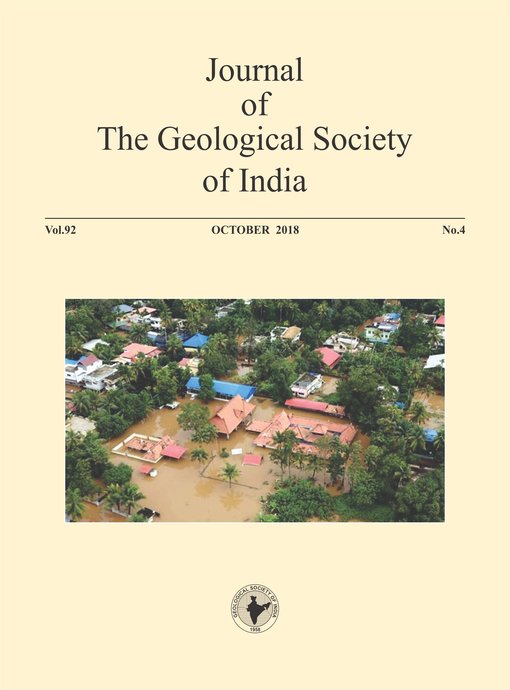Integrated Reservoir Characterization and Petrophysical Analysis of Cretaceous Sands in Lower Indus Basin, Pakistan
DOI:
https://doi.org/10.1007/s12594-018-1042-3Abstract
The reservoir character of the Cretaceous sand is evaluated in Lower Indus Basin, Pakistan where water flooding is very common. Thus, prediction of subsurface structure, lithology and reservoir characterization is fundamental for a successful oil or gas discovery. Seismic reflective response is an important tool to detect sub-surface structure. Seismic reflection response is not enough to highlight geological boundaries and fluids in the pore space therefore, the use of integrated approach is vital to map sub-surface heterogeneities with high level of confidence. Based on seismic character and continuity of prominent reflectors four seismic horizons are marked on the seismic sections. All the strata is highly disturbed and distorted with presence of a network of fault bounded horst and graben structures, which indicate that the area was under compressional tectonic regime. These fault bounded geological structure formed structural traps favorable for the accumulation of hydrocarbon. The petrophysical analysis reveals that the Cretaceous sand formation has four types of sand: Sand A, B, C and D with good porosity (15 % average) and low volume of shale. Although complete petroleum system is present with structural traps and reservoir character of sand interval is very good but these sands are highly saturated with water thus are water flooded, which is the main reason of the abundant wells in the study area.Downloads
Metrics
Issue
Section
Downloads
Published
How to Cite
References
Ahmad, N., Khan, M. (2010) Play fairway analysis and CRS mapping within a Sequence Stratigraphic Framework: screening tools for geological risk constrained exploration. PAPG-SPE Annual Technical Conference.
Alam, M.S.M.,Wasimuddin,M., Ahmad, S.S.M. (2012) Zaur Structure, A Complex Trap in a Poor Seismic Data Area, BP Pakistan Exploration & Production Inc.AAPG Search and Discovery Article PAPG/SPE Annual Technical Conference, 2-4 November2002, Islamabad, Pakistan. pp.1-3.
Archie, G.E. (1942) The electrical resistivity log as an aid in determining some reservoir characteristics. Trans Am InstMech Engg., v.146, pp.54-62.
Asquith, G., Krygowski, D. (1982) Basic Well Log Analysis. 2nd Edition.
Azeem, T., Chun, W.Y., Lisa, M., Khalid, P., Qing, L.X., Ehsan, M.I., Munawar, M.J. and Wei, X. (2017) An integrated petrophysical and rock physics analysis to improve reservoir characterization of Cretaceous sand intervals in Middle Indus Basin, Pakistan. Jour. Geophys. Engg., v.14, pp.212-225
Clavier, C., Coates, G., Dumanoir, J. (1982) The Theoretical and Experimental Basis for the ‘Dual Water' Model for the Interpretation of Shaly Sands. SPE Jour., v.24, pp.153-168.
Dresser, A. (1982) Well Logging and Interpretation Techniques, The Course for Home Study, 3rd ed., Dresser Atlas Ind., USA.
Ehsan, I.M., Ahmed, N., Khalid, P., Liu, X.W., Naeem, M. (2016) An application of rock physics modeling to quantify the seismic response of gas hydrate-bearing sediments in Makranaccretionary prism, offshore, Pakistan. Geosciences Journal, v.20(3), pp. 321-330.
Farah, A., Lawrence, R.D. (1984) An Overview of the Tectonics of Pakistan. In: Haq, B.U., Mil liman, J.D. (Eds.), Marine Geology and Oceanography of Arabian Sea and CoastalPakistan.Van No strand and Reinhold Co. and Scin. and Academic Editions, N.Y., pp. 161–176.
Gassmann, F. (1951) Uber die Elastizit a tporoser Medien. Vierteljahrsschriftderaturforschenden Gesellschaft in Zurich, v.96, pp.1-23.
Ghazi, S., Khalid, P., Aziz,T., Sajid, Z.; Hanif, T. (2015) Petrophysical analysis of a clastic reservoir rock: a case study of the Early Cambrian Khewra Sandstone, Potwar Basin, Pakistan. Geosciences Jour, v.20(1), pp.27-40.
Gnos, E., Immenhauser, A., Peters, T. (1997) Late Cretaceous / Early Tertiary Convergence betweenIndian and Arabian Plates Recorded in Ophiolites and Related Sediments. Tectonophysics, v.271, pp.1-19.
Kadri, B. (1995) Petroleum Geology of Pakistan. Pakistan Petroleum Limited Karachi.
Khalid, P., Ahmed, N. (2016) Modulus defect, velocity dispersion and attenuation in partially-saturated reservoirs of Jurassic sandstone, Indus Basin, Pakistan. Studia Geophysica et Geodaetica v.60(1), pp.112-129.
Khalid, P., Naeem, M.,Afzal, M.H., Din, Z.U., and Yasin, Q. (2014) Petroleum Play Analysis of Cretaceous Sequence, Punjab Platform, Central Indus Basin, Pakistan. Science International v.26, pp.2163-2171.
Khalid, P., Ghazi, S. (2013), Discrimination of fizz water and gas reservoir by AVO analysis: a modified approach, Act. Geod.Geophys.v.48(3), pp. 347-361.
Kemal, A. A., Zaman, S. H., Humayon, M. (1991) New directions and strategies for accelerating petroleum exploration and production in Pakistan. Proceedings, International Petroleum Seminar.
Kearey, P., Brooks, M., and Hill, I. (2002) An Introduction to Geophysical Exploration: Blackwell Publishing.
Larionov,V. V. (1969)Radiometry of boreholes (in Russian) NEDRA, Moscow.
Mahoney,J. J., Deccan Traps. In: Macdougal l, J. D., ed., (1988) Continental Flood Basalts. Kluwer Acd .Pub., Holland.151-194.
Stieber, S. J. (1970) Pulsed neutron capture log evaluation ” Louisiana Gulf Coast.Society of Petroleum Engineers Annual Fall Meeting Proceedings, SPE.pp.29-61.

 Perveiz Khalid
Perveiz Khalid






